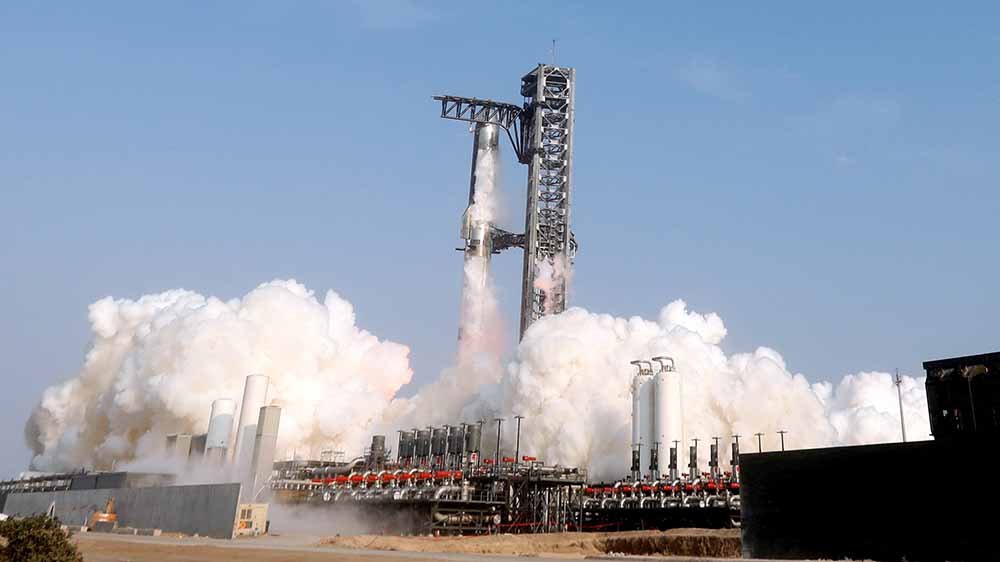Shortly before dusk on Tuesday, the world’s most powerful rocket blasted off on a test flight from its launch site in Texas.
Hopes were high for a successful SpaceX Starship mission after two explosive failed launches in January and March.
Starship comprises two parts: the “Ship” is the uppermost, and that sits atop a booster, called Super Heavy. The combined system measures just over 120m in total.
But minutes after separating from Super Heavy, it was clear something was wrong with the unmanned spacecraft. It began spinning out of control.
“We’ve essentially lost our attitude control with Starship,” a SpaceX commentator said over a live broadcast of the test flight.
The company would later confirm what it called a “rapid unscheduled disassembly”.
It was a bittersweet outcome for Elon Musk’s company.
The spacecraft tallied its greatest progress to date – surpassing that of the previous two attempts – and successfully used a previously flown booster in a significant step for its plans to design fully reusable rockets.
Ultimately, though, Starship’s ninth test flight became its third in a row to end in fiery failure.
Space X has a strong record of reliability with its most successful rocket, the Falcon 9. However, three fumbled missions months apart might leave some observers to wonder: is it all going wrong for SpaceX’s Starship?
What went wrong with Tuesday’s flight?
We still don’t really know exactly. Test data should become available in due course, which SpaceX will then use to inform the fixes it makes in time for its next flight.
Tuesday’s test mission started off much better than those previous, Dr Jonathan McDowell, an astronomer at the Harvard-Smithsonian Center for Astrophysics, told the BBC.
The ship “successfully got all the way through its orbit insertion, meaning the rocket fired for the full duration that it was meant to go”, he noted.
However, the team’s problems had already begun by this point, having lost contact with the booster. It plunged into the Gulf of Mexico rather than making the planned controlled splashdown.
Shortly afterwards, the spaceship was also forced to abort its deployment of mock Starlink satellites after the payload door got stuck and had to be closed.
Although for Dr McDowell, the “big failure” was that SpaceX could not maintain the Starship’s “attitude – it’s pointing direction – during the orbital coast”.
Despite this being Starship’s greatest progress to date, the spacecraft sprang leaks, broke up in orbit and tumbled on re-entry.
‘Fail fast, learn fast’
SpaceX operates on a principle of rapid iteration, treating test failures as learning opportunities rather than setbacks.
While this approach has led to major breakthroughs, repeated failures raise questions about long-term reliability and safety.
Nonetheless, the company hopes its “fail fast, learn fast” approach will eventually pay off, as it did when developing the Falcon line of reusable rockets.
Dr Leah-Nani Alconcel, spacecraft engineer and associate professor at the University of Birmingham, said it was not obvious that the same would be true for Starship.
“Each Starship launch is substantially more expensive than the Falcon launches were,” she told the BBC.
“Its primary aim is to send humans to Mars, a goal which is predicated on the development of a market that doesn’t exist yet, and therefore represents a bigger financial risk.
“The repeated costly and destructive failures of Starship, and the indifference to or celebration of these, also don’t project the sense that safety and reliability are the primary drivers in its development.”
Dr McDowell also predicted “more failures”.
“There is a whole new generation of space technology on this rocket,” he also noted, “so it does not really surprise me that they’re having problems”.
“I do think they’ll get it working eventually,” he added.
Has SpaceX been overly ambitious?
Mr Musk and his company have grand designs that the rocket system will one day take humans to Mars.
Nasa wants to use Starship as part of its Artemis programme, which aims to establish a long-term human presence on the Moon.
The first crewed flight is scheduled for mid-2027 but time is running out, said journalist and author Dr David Whitehouse.
Dr McDowell suggested it could take many more years for Starship to be ready for a crewed mission to the moon, which could begin to be “very embarrassing thing for Nasa to navigate”.
“In the space game, we talk about ‘Elon Time’. If he says he’s going do something in one year, make a note in your calendar for three years now”, he added.
Is there cause for optimism?
Commercial spaceflight has rapidly expanded, with private companies looking to harness space resources and build new economies beyond Earth.
With rivals such as Jeff Bezos’s Blue Origin and some Chinese ventures gaining ground, does SpaceX still have the edge?
“No one else is even trying something on the scale of Starship,” Dr McDowell said.
“If they [SpaceX] get it to work – and they have to get it to work – that will cement their position must be as the industry leader.
So despite the last three test flights having failed, is there still cause for optimism?
“Maybe not optimism, but measured confidence,” Dr McDowell said. (BBC)
Tuesday, August 26, 2025

